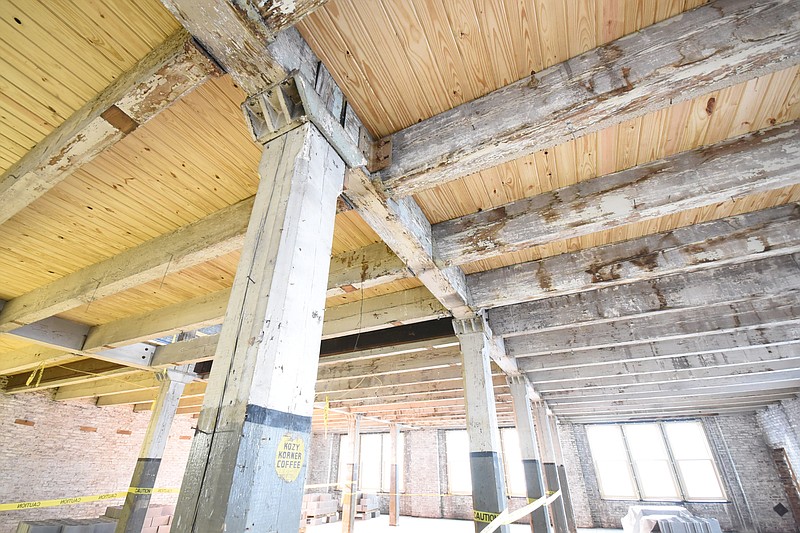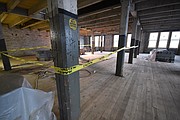Bill Glascock didn't waste time making money a decade ago when he paid $225,000 for the old Southern Saddlery building at 3001 South Broad Street in Chattanooga.
Glascock converted the four-story brick building, which is now full of small businesses, into four condominiums. He sold three of them to other landlords for a total of $325,000, and kept the fourth for himself.
"I was ahead by $100,000," says Glascock, the former mayor of Lookout Mountain, Georgia, who put the money into renovating the building which now has a list of tenants waiting to get in. "It took three years, but it was really a huge amount of fun. It's been a huge success."
Dr. Ron Coleman also got a good price in 1999, when he paid $1.25 per square foot, or $250,000, to buy the 200,000-square-foot, circa-1890, brick-and-wood Hardwick Woolen Mill in downtown Cleveland.
Coleman, a retired surgeon, was inspired to buy the historic, old mill on 7 acres with a creek flowing underneath it partly after he saw lofts in restored, old buildings in Atlanta, where his son studied art in college.
Coleman spent about a decade fixing up the Old Woolen Mill, which now has a venue for weddings, a few loft apartments and plenty of room for restaurants and other businesses. Coleman recently sold a four-story, 30,000-square-foot section of the mill as a condominium and is negotiations with another buyer for condominium space.
"Obviously, I want to make money on it. But that's really not my long-term objective," Coleman says. "I see how this could help Cleveland's downtown so much."
Glascock and Coleman are among a number of developers who repurpose old, industrial buildings for new uses. The trend started in the 1980s in Chattanooga area, experts say, and shows no signs of slowing. Old buildings can present challenges, including asbestos and lead paint that have to be removed. But the old buildings' central location, design and historic charm often win tenants over.
"People love to be downtown in older buildings with brick walls. I think they like the idea of being in a historic building," says Gerald McCormick, a principal with McCormick and Co. Real Estate.
McCormick is leasing the office space and apartments in the long-vacant Fleetwood Coffee roasting building and warehouse, a five-story, brick-and-wood building under restoration in downtown Chattanooga at 11th and King streets.
Converting old buildings to new uses, also known as "adaptive re-use," is a specialty of Morgan Construction Co.
"They're very challenging, and the end product is always very rewarding," company president Jeff Morgan says.
The construction company converted what was once an electric trolley barn at 222 Broad Street into Big River Grille & Brewing Works. It turned a 70,000-square-foot brick warehouse at 201 W. Main Street into the headquarters for Craftworks Restaurants & Breweries, the parent company of Big River and close to 200 other restaurants.
And it repurposed an old, four-story metal-sided and iron-framed mill formerly used as a milling facility by Quaker Oats into Kenco Rivermill on Amnicola Highway. The renovated structure now houses the headquarters for the Kenco Group, one of the nation's largest third-party logistics and supply chain management companies.
Morgan thinks adaptive re-use of old buildings will continue in Chattanooga, particularly on the south side of downtown.
"It's going to continue to be converted as demand for downtown office and living space continues to go up," he says.
That view is shared by architect Bill Wilkerson, whose firm, Derick, Henley & Wilkerson Architects, in 1997 converted the old Ross Meehan Foundry near Finley Stadium into the First Tennessee Pavilion, an events venue that is host to the popular Chattanooga Market farmer's market on Sundays and Wednesdays during the summer.
The old foundry was surrounded by a ramshackle collection of buildings, he says, with underground tunnels that led to the old powerhouse nearby.
"If you pulled all the [old buildings] away, there was this beautiful building in the middle of it," Wilkerson says. "You look at the original [foundry], you can't believe what's there now."
An industrial site that's ripe for re-use, according to Wilkerson, is the 141 acres along the Tennessee River and Interstate 24 on Chattanooga's western gateway that's home to the shuttered Wheland Foundry and U.S. Pipe and Valve Co. plants.
One of the proposals for that site was "Foundry Row," a 44-page plan that called for a 525,000-square-foot retail and entertainment development that would reuse the historic U.S. Pipe foundry as its main feature. The development would include a hotel, streets, sidewalks, park space and parking lots - all visible from I-24.
"They've got a magnificent building down there that they recognize needs to be preserved," Wilkerson says of the U.S. Pipe foundry.
Another potential site for re-use in Chattanooga is the Standard-Coosa-Thatcher Mill in a run-down neighborhood on South Watkins Street between East Main and East 23rd streets.
About a year ago, St. Louis, Missouri-based developer Tim Boyle proposed creating 170 new apartments in the old cotton mill, which closed in 2003. The "live-work-play" community would provide affordable housing targeted at artists. The project is still in the works, Boyle says.
"It's very difficult to put projects like this together," Boyle says. "We're close to making a positive announcement."

